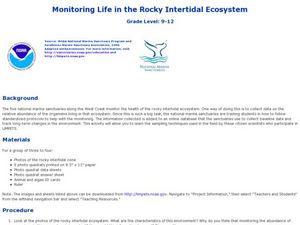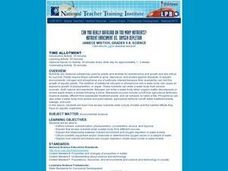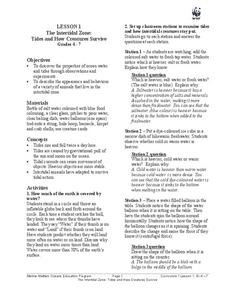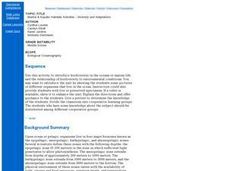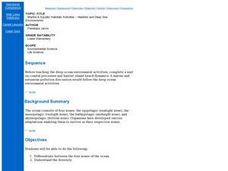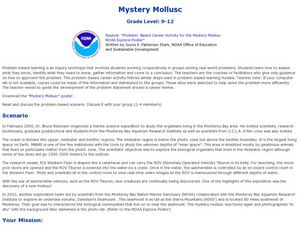Curated OER
Turning the Tide on Trash: Marine Debris Curriculum
Seven pages of fascinating reading on marine debris preface the activities in this lesson plan. Four different activities are employed to simulate how the debris is distributed in the ocean and along beaches. Early ecology learners...
Curated OER
Ocean Life
Students explore the topics of ocean water salinity, ocean life zones, marine life classification, and ocean food chains. They observe demonstrations, conduct experiments, complete quizzes and handouts, and analyze key vocabulary.
NOAA
Marine Ecosystems
Be at the top of the food chain when it comes to understanding marine ecosystems. The 21st installment of a 23-part NOAA Enrichment in Marine sciences and Oceanography (NEMO) program investigates marine ecosystems, ocean zones, and food...
Curated OER
Exploring Marine Ecosystems in the Caribbean and Maine
Students compare the marine habitats of Maine and the Caribbean using temperature, tides, ocean currents, latitude and longitude. In this marine ecosystems instructional activity, students analyze maps to complete graphic organizers that...
Curated OER
Every Square Inch Counts
Students monitor the abundance of organisms in photograph quadrats. In this environmental monitoring activity, students view pictures of rocky intertidal and subtidal marine zones and discuss the importance of monitoring organism...
Curated OER
The Magic School Bus Goes to Mussel Beach
Students investigate tides and create a model of an intertidal zone. In this hands-on marine science lesson based on a Magic School Bus book, the teacher leads students in a discussion about tides, then helps students model a tide and...
Curated OER
Marine Communities
Learners view a video and then complete lab exercises to help them explain marine communities and animals in them.
Curated OER
Monitoring Life In The Rocky Intertidal Ecosystem
Students investigate marine life by researching aquatic organisms on the Internet. In this oceanography lesson, students monitor algae and animals of the ocean by identifying their population and habitat on data sheet ID cards. Students...
Curated OER
The Intertidal Zone: Tide and How Creatures Survive
Learners explore oceanography by completing science worksheets. In this tide pools lesson, students discuss the forces of the tide pools, the animals that live within them, and the impact they have on the rest of the ocean. Learners...
Curated OER
Exploring the Beach
Students explore the beach. For this marine habitat lesson, students inspect sand grains, design beach profiles, classify marine life, and examine natural beach habitats. Students use spreadsheets to record data from their activities at...
Curated OER
Nutrient Enrichment vs. Oxygen Depletion
Learners investigate how excess nutrients enter a body of water, and the harmful effects they have on aquatic organisms.
Curated OER
Salt Water Revival
Students produce a high tide. In this Marine Biology lesson, students visit a tide pool to investigate the creatures response to changes in the tide. Students discuss the results of their experimentation.
Curated OER
The Intertidal Zone: Tides and How Creatures Survive
Students study the properties of ocean water and tides and learn about animals that live in intertidal zones. In this intertidal zone lesson, students participate in classroom stations to learn about fresh water and salt water, cold...
Curated OER
Plankton / Phytoplankton
High schoolers discuss the importance of plankton in the ocean ecosystem. In this biology lesson, students identify the different types plankton by observing them under the microscope. They explain how plankton population affect global...
Curated OER
Create an Underwater Scene
Pupils apply knowledge of underwater ocean life by creating an ocean life scene with marine animals and plants placed at appropriate ocean depths.
Curated OER
Activity 3 - Fish Anatomy: A Comparison Between Temperate and Antarctic Fishes
Students are explained that Antarctic Nototherioid fishes survive harsh conditions. These conditions would kill almost any other temperate zone organism. They work in small groups to investigate a typical temperate marine fish. ...
Curated OER
Marine & Aquatic Habitats Activities - Diversity and Adaptations
Students analyze biozones and how to identify and diagram them. They also research which organisms can adapt to different biozones.
Curated OER
Analyzing Intertidal and Deep Sea Vent Communities
Students study how scientists measure diversity. In this diversity lesson students look at marine communities and look at data to calculate diversity in 3 different ways.
Curated OER
Ocean Habitats:
Students investigate the creatures of intertidal zones. They explore the adaptations species make to survive .
Curated OER
Life In the Flood Zone
Students discover how floods occur by visiting the Weather Channel's website. They examine the areas of the United States which are more vulnerable for flooding. They research the history of previous floods and how to protect themselves.
Alabama Learning Exchange
Action at Plate Boundaries
Pupils diagram the spreading of the ocean floor. In this earth science lesson plan, students read an article on plate boundaries of the ocean. Pupils are expected to diagram the oceanic convergent boundary, and give a...
Curated OER
Habitats and Deep Sea Environments
Students examine and identify the characteristics of the four zones of the ocean. They discover the amount of diversity in marine habitats. They also explore the adaptations organisms have that have allowed them to survive.
Curated OER
The Benthic Drugstore
Students examine active chemicals that are in marine invertebrates and how they act to fight diseases. In this marine lesson students identify three pharmacologically-active chemicals, describe their disease fighting action and...
Curated OER
Mystery Mollusc
Students investigate the different regions of our oceans by researching the Internet. In this oceanography lesson, students discover the different jobs related to ocean research and examine their roles by reading related...







